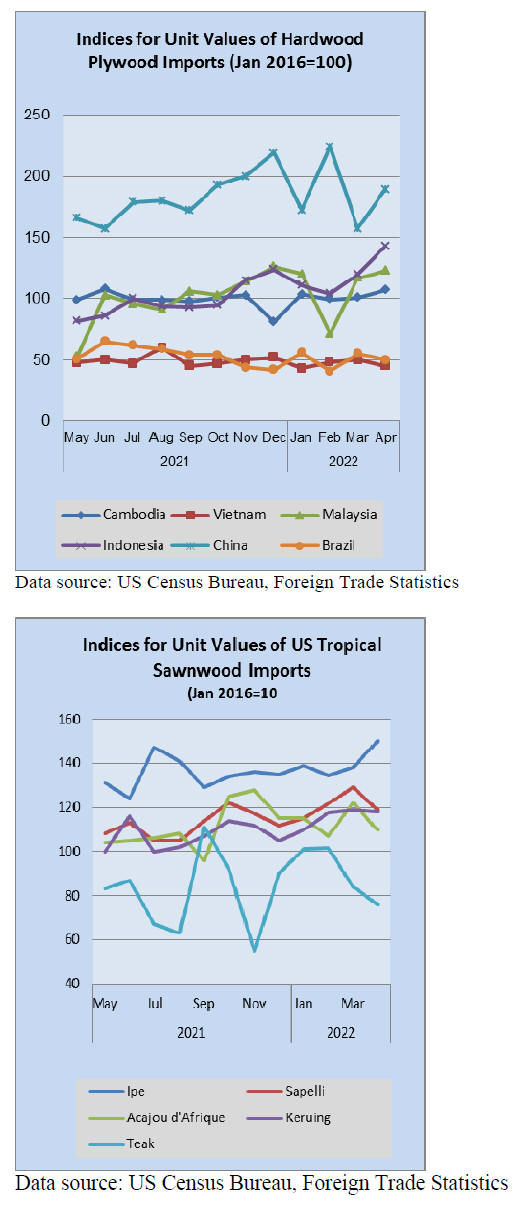|
Report from
North America
Housing starts plunge to a two-year low
Construction starts on new U.S. homes fell 14.4% in May.
The annual rate of total housing starts fell to 1.55 million
last month from a revised 1.81 million in April. The drop
is the biggest decline since April 2021 and housing starts
are at the lowest level since April 2020, when the
economy briefly fell into a steep recession at the start of
the coronavirus pandemic.
Regionally, construction looked mixed. While the
Northeast saw a 14.6% rise in the construction of new
single-family homes, the South saw a massive decline of
20.7%. Construction of single-family homes rose modestly
in the Midwest by 1.9%. In the West, that number dropped
by 17.8%.
Permitting for new homes fell 7% to 1.7 million in May
from a revised 1.82 in the prior month. The pace of
permits for new homes dropped across the country, and
was felt most sharply in the Northeast, which saw a 20.2%
decline in single-family homes.
The trend in single-family starts is downward, said
Richard Moody, chief economist at Regions Financial, as
higher mortgage interest rates will likely slow demand.
And expect this trend to persist through the year, Oxford
Economics¡¯ Nancy Vanden Houten said.
Canadian housing starts rose 8% in May compared with
the previous month, beating analyst expectations, on a
13% jump in multi-unit urban starts. The seasonally
adjusted annualized rate of housing starts was 287,257
units in May, above analyst predictions of 252,600 and a
revised 265,700 units in April, Canadian Mortgage and
Housing Corporation data showed.
See:
https://www.census.gov/construction/nrc/index.html
and
https://www.msn.com/en-us/money/realestate/us-housing-startsplunge-in-may-to-a-two-year-low/ar-
AAYxuDs?ocid=BingNewsSearch
Existing home sales tumble while prices soar
U.S. existing home sales also tumbled to a two-year low in
May as median prices jumped to a record high¡ªtopping
the US$400,000 mark for the first time¡ªand mortgage
rates increased further, pushing out entry-level buyers
from the market.
Despite the fourth straight monthly drop in sales and
declining affordability, reported by the National
Association of Realtors, the housing market remains fairly
hot, with properties typically staying on the market for a
record low 16 days. With supply still undesirably low,
prices could remain elevated, though sellers are reducing
the list price in some areas where bidding wars were
prevalent.
Existing home sales fell 3.4% to a seasonally adjusted
annual rate of 5.41 million units last month, the lowest
level since June 2020 when sales were rebounding from
the COVID-19 lockdown slump. Sales rose 1.5% in the
Northeast, but declined in the Midwest (-5.3%), the West
(-5.3%), and the South (-2.8%).
"Existing home sales should continue to slow over the
course of the year as mortgage rates move higher," said
David Berson, chief economist at Nationwide in
Columbus, Ohio. "But in the absence of a deep and
sustained economic downturn, home sales should not drop
as they did in the housing bust¡ªallowing prices to
continue to move higher on average."
See:https://www.nar.realtor/newsroom/existing-home-sales-fell-3-4-in-may-median-sales-price-surpasses-400000-for-the-firsttime
Economy added 390,000 jobs in May
Led by gains in leisure and hospitality, non-farm payroll
employment increased by 390,000 in May according to the
latest report from the U.S. Bureau of Labor Statistics. The
unemployment rate remained at 3.6%.
President Joe Biden sought to use the report to ease the
mind of Americans on inflation woes. Biden said that 8.7
million jobs have been created under his administration
with more people entering the labor market, putting the
United States in a stronger position to overcome inflation
woes in the coming months.
Leisure and hospitality employment increased by 84,000
in May, sparked by hiring growth in food services and
drinking establishments, which gained 46,000 hires.
Hiring increases were also seen in transportation and
warehousing (47,000) and construction (36,000).
Manufacturers report growth while furniture and wood
sectors lag
Economic activity in the U.S. manufacturing sector grew
in May, with the overall economy achieving a 24th
consecutive month of growth, say the nation's supply
executives in the latest Manufacturing ISM Report on
Business.
However, the Wood Products sector and the Furniture &
Related Products sector were among the laggards for the
month. Of the 18 manufacturing industries, 15 reported
growth in May while Furniture & Related Products was
the only sector to report a decline. The Wood Products
sector reported no change from the previous month.
Eleven manufacturing industries reported an increase in
new orders in May. The only industry reporting a decline
in new orders in May was Wood Products, while Furniture
& Related Products executives reported no change.
See:
https://finance.yahoo.com/news/manufacturing-pmi-56-1-may-140000919.html
Consumer sentiment darkens amid soaring gas prices
Consumer sentiment declined by 14% from May,
continuing a downward trend over the last year and
reaching its lowest recorded value, comparable to the
trough reached in the middle of the 1980 recession. All
components of the sentiment index fell this month, with
the steepest decline in the year-ahead outlook in business
conditions, down 24% from May.
Half of all consumers spontaneously mentioned gasoline
during their interviews, compared with 30% in May and
only 13% a year ago. Consumers expect gas prices to
continue to rise a median of 25 cents over the next year,
more than double the May reading and the second highest
since 2015. In addition, a majority of consumers
spontaneously mentioned supply shortages for the ninth
consecutive month.
See:
http://www.sca.isr.umich.edu/
Cabinet sales fall
According to the Kitchen Cabinet Manufacturers
Association¡¯s (KCMA) monthly Trend of Business
Survey, participating cabinet manufacturers reported a
decrease in overall sales of 13.8% in May from the
previous month. Custom sales fell by 14.5%, while semicustom
sales fell 8.8%, stock sales fell 16.8% and
estimated cabinet quantity was down 15.6% versus April
2022. However, compared with a year ago, sales in all
categories were up by more than 10% except for estimated
cabinet quantity which decreased 3.7% versus May 2021.
See:
https://kcma.org/news/april-2022-trend-business-pressrelease

|